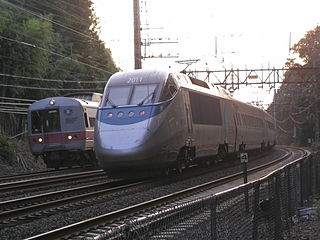Happening Now
Pay no attention to the tax-sucking behemoths behind the curtain
November 25, 2013
Written By Colin Leach

Amtrak's Acela Express. Photo credit to Connor Harris via Wikimedia Foundation
As might be expected, last week’s kangaroo court-style hearing into Amtrak’s food and beverage service has caused critics of the railroad to emerge from the woodwork. These critics have rehashed tired claims against passenger rail in the United States, arguing that it’s a money-losing proposition that has no real future.
But none has argued that point with such vehemence and vitriol as Jim Epstein. Writing for The Daily Beast, Epstein argues that Amtrak is a “tax-sucking behemoth” that needs to be killed “once and for all”. He contends that last week’s hearings into food and beverage service are merely symptomatic of a claimed “chaotic management culture” that oversees huge misallocations of funds and is subservient to purportedly domineering unions. As if these were not offenses enough, Epstein also asserts that Amtrak is simply unnecessary. He insists that the railroad only accounts for a tiny fraction of intercity passenger trips. Why should taxpayer dollars be used to subsidize a supposedly unpopular travel choice?
Unfortunately for Epstein (and fortunately for rail advocates), his critiques are nothing more than caricatures of every argument dragged out against Amtrak since its creation in 1971. Despite these constant predictions of doom and gloom, trains are more popular than ever with Americans--Amtrak carried a record 31.6 million passengers in Fiscal Year 2013, setting the tenth ridership record in eleven years. And states are stepping up across the nation to invest in the expansion of short distance routes. But let’s focus on his chief point: that Amtrak is a singularly massive drain on public finances, whereas highways and aviation are profitable.
Such a claim is simply absurd. Epstein cites a 2004 federal study that claims highways produce “excess revenue”. However, developments in the intervening ten years have shown this claim to be an essential falsification. If it were true that interstate highways produced excess revenue, then it would follow that there should be no problem in their continued financing. But we know that since 2008, Congress has bailed out the Highway Trust Fund to the tune of $53 billion, a figure expected to climb in the future as gas tax receipts continue to decline.
Nor, for that matter, does this assertion of “excess revenue” take into account the huge external costs imposed by a highway-centric transportation system. As we reported to you back in May, economists at the University of Geneva concluded that the costs of increased greenhouse gas emissions and higher mortality rates from auto use are enormous. By expanding rail service, these costs can be significantly lowered.
Concerning aviation, Epstein’s arguments also fall short. As Harvard economist Edward Glaeser pointed out in a March editorial, airlines are recipients of huge federal subsidies that cover both operational and security expenses. Furthermore, when one considers the reality that airports themselves are owned and operated by local governments -and not by the airlines- the level of public subsidy is even greater.
Passenger rail requires public investment- as do highways and air travel. And passenger rail has a unique set of benefits that make it particularly well suited to efficiently moving a large number of people through densely populated corridors. We also cannot forget that passenger rail is a part of a complex, multimodal transportation network. Consider what happened in the Northeast during last year’s Hurricane Sandy. When flooding in Manhattan shut down the Northeast Corridor, airlines and bus operators were unable to handle Amtrak’s passengers as well as their own. Multimodalism is key to ensuring that the nation’s transportation needs can be met on many different levels.
Furthermore, as we have stressed time and again, Amtrak serves communities that otherwise lack public transportation choices. Despite Epstein’s claims to the contrary, intercity bus operators are actually reducing service to rural routes. And, as MIT found in a recent study, airline mergers mean smaller markets lose more and more of their flights, leaving many communities without any form of public transportation.
Passenger rail can economically, efficiently, and reliably serve the entire nation. Passenger trains not only link smaller communities to larger markets, they also afford unique opportunities for revitalization of moribund downtown areas and overall job creation. The true “tax-sucker” is overreliance on publicly-subsidized airports and highways that hide the true costs of air and bus travel. Compared to that, a balanced transportation network is a bargain.
Written by Colin Leach with edits and input from Sean Jeans-Gail and Malcolm Kenton.
"I’m so proud that we came together in bipartisan fashion in the Senate to keep the Southwest Chief chugging along, and I’m grateful for this recognition from the Rail Passengers Association. This victory is a testament to what we can accomplish when we reach across the aisle and work together to advance our common interests."
Senator Tom Udall (D-NM)
April 2, 2019, on receiving the Association's Golden Spike Award for his work to protect the Southwest Chief
Comments